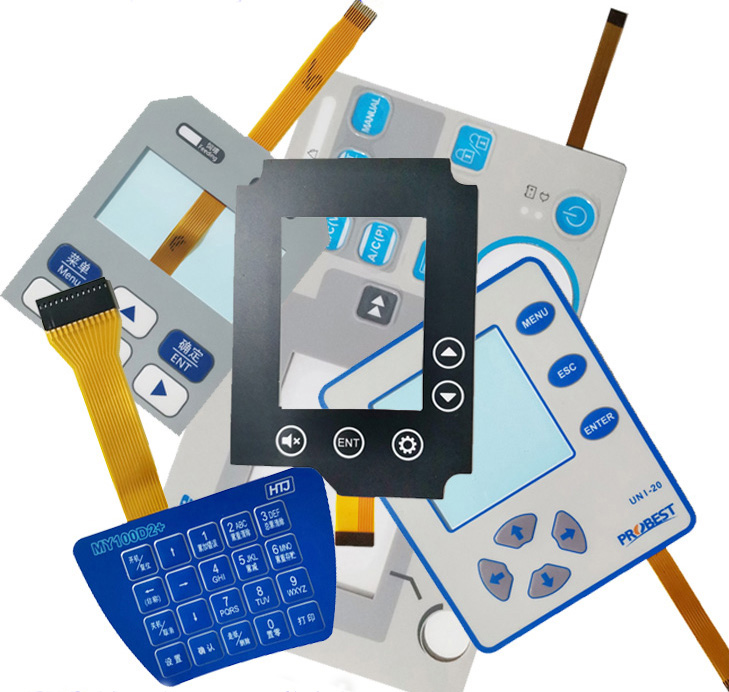Recognizing Membrane Layer Switches: The Key to Trustworthy and resilient Controls
Membrane switches over stand for a crucial facet of modern-day interface style, blending functionality with resilience in different applications. As we discover the complexities of membrane switches, it comes to be clear that their role in improving control systems is both profound and intricate, elevating inquiries concerning how ideal to take advantage of their abilities in future innovations.
What Are Membrane Layer Switches?
Membrane buttons are a sophisticated remedy in the realm of individual interface innovation, combining functionality and style effortlessly. These devices serve as an interface between customers and electronic systems, incorporating several elements right into a portable layout. Normally constructed from versatile, slim layers of materials, membrane layer buttons are developed to react to touch, allowing users to interact with machinery and electronic gadgets efficiently.
The primary elements of a membrane button consist of a published circuit layer, graphic overlay, and a spacer layer that protects against unintended activation. The graphic overlay can be customized to show brand name identification or customer preferences, enhancing looks while ensuring use. Membrane buttons are commonly utilized in numerous applications, including medical tools, consumer electronics, and industrial equipment, owing to their longevity and resistance to ecological aspects such as wetness and dust.
One of the crucial benefits of membrane switches is their ability to withstand damage, making them optimal for high-traffic environments. In addition, they are light-weight and call for marginal area, enabling innovative styles in product development. On the whole, membrane switches over stand for a efficient and useful option for modern digital user interfaces, weding modern technology with user-centric design concepts.
How Membrane Switches Over Work
The operation of membrane layer changes hinges on a straightforward yet effective system that equates user input right into electronic signals. When a user presses the button, the leading layer deforms, enabling a conductive aspect in the circuit layer to make contact with a corresponding conductive pad on the bottom of the visuals overlay.
The design of membrane switches can vary, but they often incorporate domes or tactile aspects to offer feedback to the individual, improving the total experience. The products used in membrane buttons, such as polyester or polycarbonate, add to their longevity and resistance to environmental factors, including moisture and dirt. In addition, the published circuits are commonly enveloped, which secures them from damage over time.

Benefits of Membrane Layer Buttons
Among the main advantages of membrane buttons is their versatility in design, enabling them to be tailored to fulfill particular individual requirements and aesthetic requirements. This versatility reaches numerous markets, where different shapes, sizes, and shades can be employed to improve click here to find out more user communication and aesthetic charm.
Furthermore, membrane layer switches are known for their resilience. Constructed from durable materials, they are resistant to dust, dampness, and physical wear, which significantly extends their lifespan contrasted to conventional mechanical switches. This durability makes them especially suitable for high-traffic atmospheres and applications needing long life.

In addition, membrane switches use a streamlined account, bring about a thinner layout that can be integrated into various gadgets without including mass. This feature not just improves the visual allure but additionally adds to a more ergonomic product design.

Applications of Membrane Layer Buttons
User-friendly and flexible, membrane buttons discover applications across a broad variety of industries, including clinical gadgets, customer electronics, and commercial equipment. In the medical area, these switches are essential to devices such as analysis tools, person tracking systems, and infusion pumps, where integrity and simplicity of cleaning are essential. Their ability to maintain and endure harsh environments capability makes them suitable for such applications.
In customer electronic devices, membrane layer buttons are used in products like microwaves, washing machines, and push-button controls - membrane switch. Their smooth design permits intuitive interface, enhancing the total user experience while offering toughness and resistance to tear and use
Commercial devices additionally benefits from membrane buttons, specifically in control panels for equipment and automation systems. These buttons supply protection versus dust and dampness, making sure regular efficiency in difficult settings. Moreover, their adjustable functions allow makers to customize them to details operational demands, improving performance and capability.
Picking the Right Membrane Layer Change
When picking a membrane switch, it is necessary to take into consideration different factors that influence performance and viability for specific applications. The primary factors to consider include ecological problems, tactile feedback, view publisher site durability, and layout specifications.
First, analyze the operating environment; switches revealed to dampness, chemicals, or severe temperature levels require particular materials to make certain longevity and performance. Next, review the need for responsive feedback. Depending on user communication, some applications might take advantage of a responsive reaction to confirm activation, while others might favor a non-tactile layout for visual reasons.
Sturdiness is one more critical factor; membrane layer switches should be created to withstand regular usage, influences, and abrasion. Make sure the selected button can endure the expected lifecycle, particularly in high-usage situations.
Verdict
In final thought, membrane changes serve as important components in the layout of trusted and long lasting control systems throughout numerous sectors. The convenience of membrane switches permits for tailored services that satisfy details operational demands, reinforcing their significance in modern-day technology.
Membrane layer switches stand for a critical facet of modern-day interface layout, blending capability with strength in various applications.Membrane buttons are an advanced solution in the world of customer interface modern technology, combining capability and style perfectly. Usually constructed from adaptable, thin layers of products, membrane layer switches are developed to react to touch, making it possible for users to engage with machinery and digital tools efficiently.
The design of membrane layer buttons can differ, however they commonly incorporate domes or responsive aspects to offer feedback to the customer, improving the general experience.In final thought, membrane changes offer as necessary parts in the style of dependable and long lasting control systems across numerous sectors.